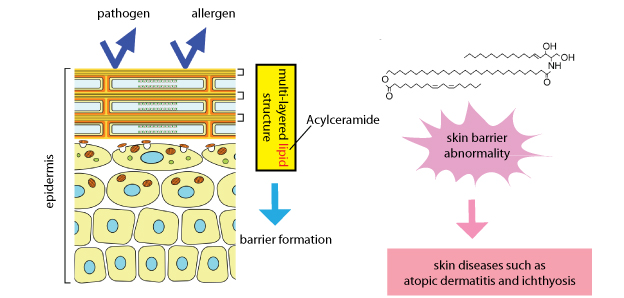Elucidation of the Molecular Mechanism of Skin Barrier Formation: Expectations for the Development of Treatment Drugs for Skin Diseases such as Atopic Dermatitis and Ichthyosis
Research Press Release | June 12, 2015

Skin is composed of an outer epidermis and an inner dermis. The outermost layer of the epidermis (the stratum corneum) forms a barrier to prevent the entry of pathogens and allergens. Accordingly, abnormalities of the skin barrier cause skin diseases such as atopic dermatitis and ichthyosis. The barrier at the stratum corneum is a multi-layered lipid structure, and among those lipids, acylceramide, which is only found in the epidermis, plays a particularly important role in barrier formation. This research focused on the molecular mechanism of acylceramide production, an area that until now was largely unknown, and has succeeded in identifying a gene that acts in acylceramide production.
| Press Release | ||
|---|---|---|
| Key Points |
|
|
| Overview |
Abnormalities of the skin barrier cause skin diseases such as atopic dermatitis and ichthyosis. The skin barrier is substantially composed of lipids, and among them the lipid, acylceramide, is the most important. We focused on the molecular mechanism by which acylceramide is produced, and clarified that the enzyme named CYP4F22 (a member of the cytochrome P450*3 family) acts in the hydroxylation of the omega ends*4 of ultra-long-chain fatty acids*5, which is an important step in the process by which acylceramide is produced. We have also clarified the type of reaction continuity with which acylceramide production occurs. These results are expected to lead to a new treatment strategy of treating skin disease by skin barrier strengthening. Notes: *1) Acylceramide: A type of ceramide molecule that is only found in the epidermis and is important for skin barrier formation. Structurally different from typical ceramides, the omega end of the fatty acid portion is acylated (addition of linoleic acid). *2) Ichthyosis: As indicated by the name, the stratum corneum of the epidermis accumulates abnormally and becomes thicker than normal so that the surface of the skin resembles fish scales. *3) Cytochrome P450: A type of enzyme that performs oxidation reactions. Approximately 50 types occur in humans. *4) Omega end: The opposite end of the carbon chain of a fatty acid molecule from the carboxyl end. *5) Ultra-long-chain fatty acid: A fatty acid in which the chain is extremely long (26 or more carbon atoms). |
|
| Inquiries |
Coordinating Office, Future Drug Discovery and Medical Care Innovation Project, Hokkaido University Publicity liaison: Ms. Wada Phone: +81-11-706-7798 FAX: +81-11-706-7799 E-mail: innovation@cris.hokudai.ac.jp |
|
|
Japanese Link |
皮膚バリア形成の分子機構を解明-アトピー性皮膚炎や魚鱗癬などの皮膚疾患の治療薬の開発に期待- | |
| Publications | Essential role of the cytochrome P450 CYP4F22 in the production of acylceramide, the key lipid for skin permeability barrier formation, Proceedings of the National Academy of Sciences of the United States of America (2015.6.9) | |
